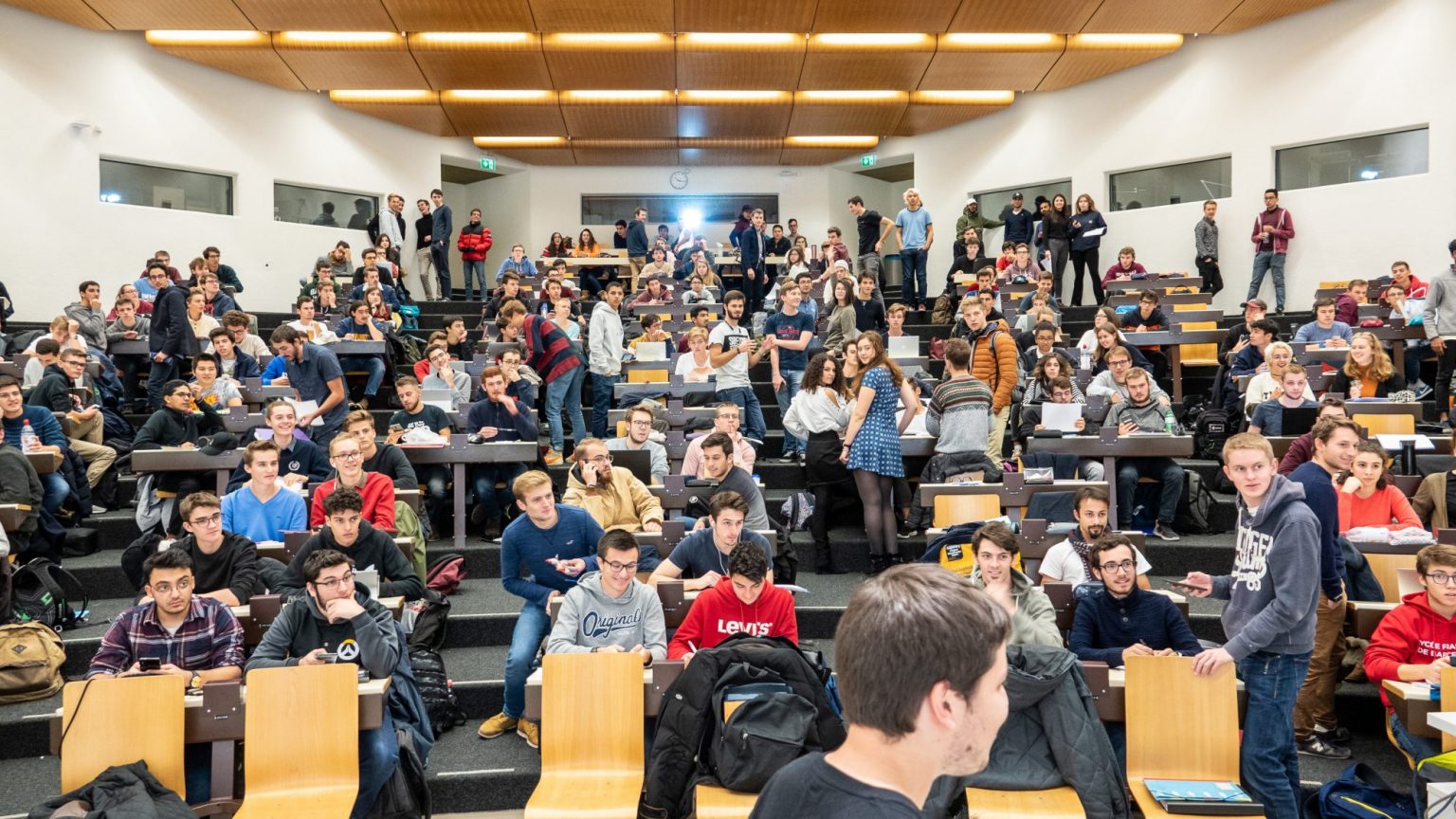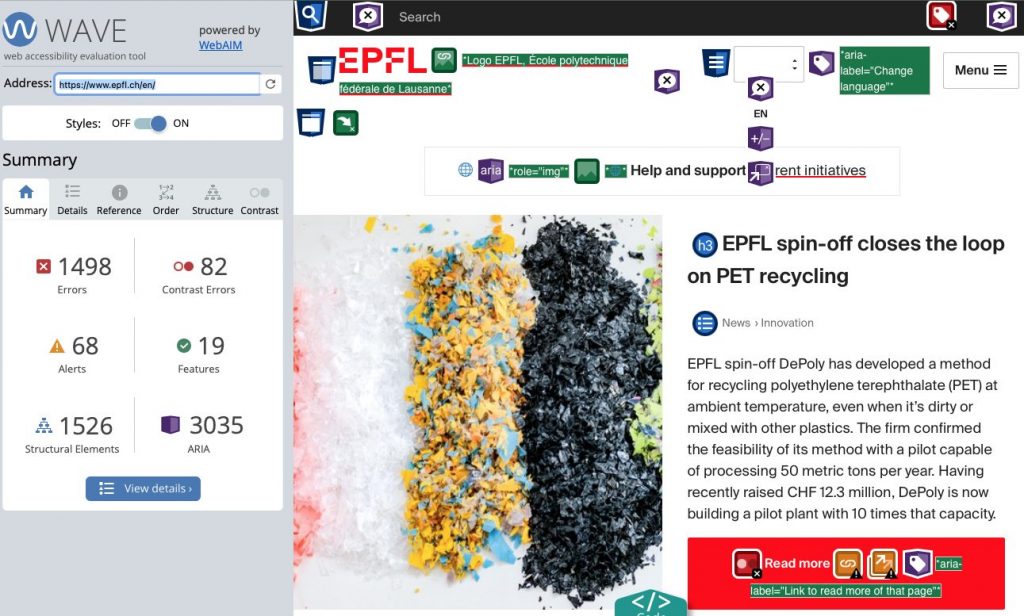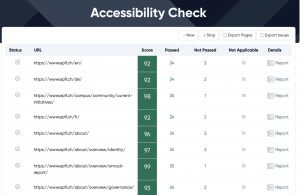Improving Access and Inclusion

Students getting in their seats before the class “Materials: from chemistry to properties” taught by Eva Klok-Lermann and Véronique Michaud. The course teaches key concepts that relate the structure of matter, equilibria and chemical reactivity to the mechanical, thermal, electrical, magnetic and optical properties of materials. Copyright: Olivier Christian/EPFL
Access and Inclusion in Higher Education
EPFL aims to provide an inclusive and accessible and inclusive environment for all its students and staff, so that everyone can thrive and succeed. The Center for Digital Education (CEDE) can help you implement certain measures to enhance the accessibility of your courses, e.g. by recording your lectures and implementing interactive educational technologies. Below we provide some background and discuss how and why certain tools may help to create more equitable education.
Accessibility and inclusion in higher education
Despite the increasing student enrolments of the last decades, higher education remains largely inaccessible: students with caring responsibilities, and students with disabilities or chronic illness have lower chances to access and complete higher education programs (2,3).
For example, the Swiss Federal Statistical Office estimates that around 20% of the Swiss population lives with disabilities (4). However, when it comes to higher education, the share of persons with disabilities is only around 8% (5), and data from the United States on the participation of persons with disabilities in US higher education show that their representation among STEM programs is even lower (6,7,8,9).
Barriers to access and inclusion
Students living with a chronic illness, a disability, or with caring responsibilities face various barriers when accessing and completing higher education programs. These barriers include:
- Time and scheduling challenges, housing and commuting issues, and financial problems, which are commonly faced by students with chronic illnesses or students with caring responsibilities (12).
- Transportation challenges, difficulties accessing campus facilities, noisy or overcrowded classrooms, impaired communication, and a lack of information, which are obstacles encountered by students with physical or mental disabilities (e.g. ADD/ADHD, Autism)(13).
These challenges and barriers ultimately contribute to poorer academic performance and higher dropout rates for these students compared to their peers (13, 14).
Additional detrimental impact is caused by the lack of awareness amongst teaching staff and inconsistent or overly bureaucratic (institutional) policies. This forces some students to continually ask for adjustments and often this support is not even provided, e.g. no lecture notes or slides in advance of the lecture or lectures may not be recorded (8, 14, 15,16).
What we can lean from distance education
The solutions towards enhancing accessibility and inclusiveness of higher education for all students are diverse, highly individualised, and context dependent (13, 17). However, a relevant model in this respect is that of (open) distance education and the institutions that have traditionally catered to student populations who did not have access to regular higher education (18). Several technologies typically used in distance education may offer substantial benefits for students who have lower chances to access and complete higher education programs (19, 20)
For example, recordings of lectures offer good opportunities for students with disabilities. Students with disabilities and medical conditions at University of Western Australia rated lecture recordings as an ‘Essential’ (66%) or ‘Useful’ (32%) learning resource (20). In the Review of Support for Disabled Students in Higher Education in England (21), the “availability of recorded video lectures” is even a key indicator for accessibility and inclusiveness of education for disabled students. And many universities now have policies that set lecture recording as a default for all courses and all teachers, stating improving accessibility as a reason (e.g., Imperial College, Oxford, Edinburgh).
Another good practice of many distance education programs is the explicit support for Self Regulated Learning (SRL) skills (29). Such support has beneficial effects for the development of SRL skill and for academic performance (22, 23, 24) and underachieving students seem to benefit most (25).
Furthermore, many distance learning programs offer a discussion board: a platform for students to communicate asynchronously and anonymously with teachers and students, and see communication of other students and teachers. The active and passive use of these discussion boards has been proven to benefit (online) learning (26, 27), especially for students that experience barriers in face-to-face communication in regular classrooms (28).
Conclusion
During Covid-19 pandemic most courses in EPFL were offered as distance courses, with materials offered online and lectures live-streamed and recorded. The collection of online materials that resulted from this period proved to be a valuable and frequently used resource for our students, even after the pandemic when education was organised face-to-face. The reasons for this continued use may be varied and multi-faceted, and different students may have different reasons to use different materials for different courses and from different teachers. And it is therein that its strength lies: the availability of online resources introduces more flexibility for the individual student, and this flexibility may lead to more accessible and inclusive education.
Video lectures offer a better acoustic experience: Documenting the experiences of disabled students, Fuller, Bradley & Healey (30) found that hearing impaired students often struggle to follow the teacher’s presentation and discussion in the classroom. Teachers turn towards the whiteboard while speaking, or students are expected to take notes at the same time, all creating challenges to keep track of what the teacher is saying, especially for the deaf and hearing impaired, and for second language students.
Video lectures help overcome that problem by providing consistent high quality sound: recordings are often done with a microphone and the comprehensibility of the recorded speech can be enhanced in the post-production process. While watching, students can manipulate the speed of the video lecture, and thus have more control over their learning process.
Video lectures can be enriched with closed captions, subtitles and audio descriptions: Videos also offer the opportunity to include captions and subtitles, thus making a lecture easier to follow for the deaf and hearing impaired (31) and second language students, i.e. students for whom sign language or a foreign language is their first language. A systematic review of empirical studies investigating the effect of closed captioning for deaf and hearing impaired students showed the use of video closed captions helped these students learn better than with language interpreters (32).
Video closed captions and subtitles also offer advantages for the visually impaired: the closed captions with audio description of visual information can be read aloud, and thus necessary explanations become available that are usually not available in the classroom lectures. This is particularly relevant in STEM fields where teaching relies heavily on graphical information, with charts, graphs, diagrams, and engineering drawings (33, 34, 35).
Recorded video lectures are better than live-stream videos in this respect, because live captioning systems do not seem to work very well for highly technical domains (8).
Video lectures are time and location independent: The time, space and pace independence of video lectures has several benefits for many students. There is the obvious benefit for mobility impaired students, and students who have caring responsibilities: they can access the lectures wherever and whenever they want, with very low physical effort (36, 39). But another benefit lies in being able to control the pace of a lecture: this allows students to follow the lecture at their own speed, take breaks when needed (38), and obviate the need to listen and take notes at the same time.
Furthermore, students with anxiety or mental problems can benefit because they would be able to avoid busy campuses. For example, a qualitative study into the experiences of students with Asperger syndrome (37) showed that they experience sensory overload and social anxiety in crowded places on campus. Such anxiety or sensory overload may negatively impact the learning value of a lecture, or it has students avoid the classroom lecture all together.
Discussion boards allow for time and space independent communication: The time and location independence of this form of communication – if consistently used – helps to overcome lack of information and general communication issues for students who can’t visit campus regularly (12, 13). As such, discussion boards offer communication that requires little or no physical effort.
Discussion boards allow for more barrier free communication: Discussion boards allow for more flexible and equitable communication because students can use different input devices or languages, and have tools available for translation or narration. This can be a great help for students who experience communication challenges on campus: second language students, deaf students, or neurodiverse students, e.g. students with autism, attention deficit hyperactivity disorder (38).
Discussion boards allow for anonymous Q&A: Students have shown to be more active, open and responsive in discussion boards when they can post questions and answers anonymously (40). Where this may be especially relevant and beneficial for neurodiverse students who experience anxiety when interacting with teachers or other students, it also mitigates the risk of bias towards or stigmatisation of certain students and their contributions, thus it can increase their sense of belonging (41).
An online support for SRL complements the role of the teacher in control and management of learning: SRL skills have been proven to foster learning and are especially important for students who are more isolated – due to e.g. chronic illness, disability or caring responsibilities. For these students who may miss out on campus activities and follow lectures at a distance, tasks that would otherwise be carried out by the educators or peers, such as setting goals and evaluating progress, now become the students’ own responsibilities (24). The EPFL Learning Companion allows students to self-assess on three levels. It invites them to reflect on their learning habits, problem-solving strategies, and their project management skills, hopefully to successfully manage and adapt their learning behaviours. Feedback provided by the Learning Companion directs students to specific sections of an online course which describes practical study strategies and methods.
Universal Design Principles
Universal Design is the design and composition of a (virtual) environment so that it can be accessed, understood and used to the greatest extent possible by all people regardless of their age, size, ability or disability. The designer is not expected to find one design solution that accommodates the needs of all, ut rather, explore design solutions that are more inclusive and accessible. You can find more information here: https://universaldesign.ie/about-us/
Check your webpage with online tools
Wave is a suite of tools that helps authors to make their web content more accessible to individuals with disabilities. You can enter your web page address and do a quick check to assess the accessibility of your webpage, or use their API or testing engine to collect accessibility on many webpages. You can find more information here: https://wave.webaim.org/

With EXPERTE.com’s Accessibility Checker, you can find out how accessible your website is. The tool crawls your site, making sure that each subpage can be correctly displayed by screen readers, allowing even blind and visually-impaired users to make full use of it.
The accessibility test assesses 41 features across eight categories. Read more on their website.
WCAG: Web Content Accessibility Guidelines (W3C)
A set of technical standards and guidelines developed by the World Wide Web Consortium (W3C) for accessible webpages and improving user experience. You can find resources to help you with design, coding and content. WCAG isn’t a legal requirement, but a set of globally adopted standards The focus is on overall experience, and the WAI-ARIA (below) give you the criteria in the context of separate technical components. You can find more information here: https://wcag.com/resource/what-is-wcag/
WAI-ARIA standard (W3C)
The Web Accessibility Initiative – Accessible Rich Internet Applications published by the World Wide Web Consortium (W3C). WAI-ARIA is a technical specification on how to increase web page accessibility for people with disabilities, for example for people who use screen readers or can’t use a mouse. Find more information here: https://www.w3.org/WAI/standards-guidelines/aria/
AbilityNet
AbilityNet is a pioneering UK charity that holds a global perspective, advocating for the availability of digital technology to people of all abilities and ages. Their extensive range of free online resources and network of over 300 community-based volunteers offer assistance to individuals with disabilities, regardless of age, enabling them to navigate and utilize various digital technologies. Their overarching vision is to create a digital world that is accessible to all, promoting inclusivity and equal access for everyone. Find more information here: https://abilitynet.org.uk/
Link to the accessible HTML version of the PDF flip book above.
- Marginson, S. (2016). The worldwide trend to high participation higher education: Dynamics of social stratification in inclusive systems. Higher Education, 72, 413–434. https://doi.org/10.1007/s10734-016-0016-x
- OECD. (2018). Equity in Education: Breaking Down Barriers to Social Mobility. OECD. https://doi.org/10.1787/9789264073234-en
- Structural indicators for monitoring education and training systems in Europe – 2022: Overview of major reforms since 2015. (2022). Eurydice.
- Equality of people with disabilities. (2020). Bundesambt für Statistik. https://dam-api.bfs.admin.ch/hub/api/dam/assets/15003397/master
- Cardoso, C. (n.d.). University for all: Making higher education more inclusive. UN Today. Retrieved May 15, 2023, from https://untoday.org/university-for-all-making-higher-education-more-inclusive/
- Booksh, K. S., & Madsen, L. D. (2018). Academic pipeline for scientists with disabilities. MRS Bulletin, 43(8), 625–631. https://doi.org/10.1557/mrs.2018.194
- Moon, N., Todd, R., Morton, D., & Ivey, E. (2012). Accommodating Students with Disabilities in Science, Technology, Engineering, and Mathematics (STEM) | Center for Advanced Communications Policy. https://cacp.gatech.edu/publications/pub/5903
- Shinohara, K., McQuaid, M., & Jacobo, N. (2020). Access Differential and Inequitable Access: Inaccessibility for Doctoral Students in Computing. The 22nd International ACM SIGACCESS Conference on Computers and Accessibility, 1–12. https://doi.org/10.1145/3373625.3416989
- Shinohara, K., McQuaid, M., & Jacobo, N. (2021). The Burden of Survival: How Doctoral Students in Computing Bridge the Chasm of Inaccessibility. Proceedings of the 2021 CHI Conference on Human Factors in Computing Systems, 1–13. https://doi.org/10.1145/3411764.3445277
- Reed, M. J., Kennett, D. J., & Emond, M. (2015). The influence of reasons for attending university on university experience: A comparison between students with and without disabilities. Active Learning in Higher Education, 16(3), 225–236. https://doi.org/10.1177/1469787415589626
- Herbaut, E., & Geven, K. (2020). What works to reduce inequalities in higher education? A systematic review of the (quasi-)experimental literature on outreach and financial aid. Research in Social Stratification and Mobility, 65, 100442. https://doi.org/10.1016/j.rssm.2019.100442
- Iyamu, J., & Brown, E. (n.d.). An invisible minority: What is needed to support students with caring responsibilities. Campus. Retrieved June 2, 2023, from https://www.timeshighereducation.com/campus/invisible-minority-what-needed-support-students-caring-responsibilities
- Mack, K., McDonnell, E., Potluri, V., Xu, M., Zabala, J., Bigham, J., Mankoff, J., & Bennett, C. (2022). Anticipate and Adjust: Cultivating Access in Human-Centered Methods. CHI Conference on Human Factors in Computing Systems, 1–18. https://doi.org/10.1145/3491102.3501882
- Hopkins, L. (2011). The path of least resistance: A voice‐relational analysis of disabled students’ experiences of discrimination in English universities. International Journal of Inclusive Education, 15(7), 711–727. https://doi.org/10.1080/13603110903317684
- Mortimore, T. (2013). Dyslexia in higher education: Creating a fully inclusive institution. Journal of Research in Special Educational Needs, 13(1), 38–47. https://doi.org/10.1111/j.1471-3802.2012.01231.x
- Redpath, J., Kearney, P., Nicholl, P., Mulvenna, M., Wallace, J., & Martin, S. (2013). A qualitative study of the lived experiences of disabled post-transition students in higher education institutions in Northern Ireland. Studies in Higher Education, 38(9), 1334–1350. https://doi.org/10.1080/03075079.2011.622746
- Torotcoi, S., Gologan, D., & Kurysheva, A. (2020). What Works for Underrepresented Groups? Identifying Effective Measures for Enhancing Access to Higher Education in Europe. In A. Curaj, L. Deca, & R. Pricopie (Eds.), European Higher Education Area: Challenges for a New Decade (pp. 177–196). Springer International Publishing. https://doi.org/10.1007/978-3-030-56316-5_13
- Beaton, C. (2019). Distance Learning as a Levelling Tool for People with Disabilities. 2019 International Conference on Computational Science and Computational Intelligence (CSCI), 884–887. https://doi.org/10.1109/CSCI49370.2019.00168
- Lee, K. (2017). Rethinking the accessibility of online higher education: A historical review. The Internet and Higher Education, 33, 15–23. https://doi.org/10.1016/j.iheduc.2017.01.001
- Williams, J., & Fardon, M. (2007). Lecture recordings: Extending access for students with disabilities: Lecture recordings: extending access for students with disabilities. ALT-C 2007: Beyond Control, Learning Technology for the Social Network Generation, Research Proceedings, 1, 139–148.
- Wong, J., Baars, M., de Koning, B. B., & Paas, F. (2021). Examining the use of prompts to facilitate self-regulated learning in Massive Open Online Courses. Computers in Human Behavior, 115, 106596. https://doi.org/10.1016/j.chb.2020.106596
- Wong, J., Baars, M., Davis, D., Van Der Zee, T., Houben, G.-J., & Paas, F. (2019). Supporting Self-Regulated Learning in Online Learning Environments and MOOCs: A Systematic Review. International Journal of Human–Computer Interaction, 35(4–5), 356–373. https://doi.org/10.1080/10447318.2018.1543084
- Devolder, A., van Braak, J., & Tondeur, J. (2012). Supporting self-regulated learning in computer-based learning environments: Systematic review of effects of scaffolding in the domain of science education. Journal of Computer Assisted Learning, 28(6), 557–573. https://doi.org/10.1111/j.1365-2729.2011.00476.x
- Williams, M., Pollard, E., Takala, H., & Houghton, A.-M. (2019). Review of Support for Disabled Students IN Higher Education in England (p. 145). Institute for Employment Studies. https://www.officeforstudents.org.uk/media/a8152716-870b-47f2-8045-fc30e8e599e5/review-of-support-for-disabled-students-in-higher-education-in-england.pdf
- Raković, M., Bernacki, M. L., Greene, J. A., Plumley, R. D., Hogan, K. A., Gates, K. M., & Panter, A. T. (2022). Examining the critical role of evaluation and adaptation in self-regulated learning. Contemporary Educational Psychology, 68, 102027. https://doi.org/10.1016/j.cedpsych.2021.102027
- Almatrafi, O., & Johri, A. (2019). Systematic Review of Discussion Forums in Massive Open Online Courses (MOOCs). IEEE Transactions on Learning Technologies, 12(3), 413–428. https://doi.org/10.1109/TLT.2018.2859304
- Du, Z., Wang, F., Wang, S., & Xiao, X. (2022). Enhancing Learner Participation in Online Discussion Forums in Massive Open Online Courses: The Role of Mandatory Participation. Frontiers in Psychology, 13. https://www.frontiersin.org/articles/10.3389/fpsyg.2022.819640
- Jay, V., Henricks, G., Anderson, C., Angrave, L., Bosch, N., Williams-Dobosz, D., Shaik, N., Bhat, S., & Perry, M. (2020). Online Discussion Forum Help-Seeking Behaviors of Students Underrepresented in STEM. In Grantee Submission. https://eric.ed.gov/?id=ED610615
- Perez-Alvarez, R., Jivet, I., Pérez-Sanagustin, M., Scheffel, M., & Verbert, K. (2022). Tools Designed to Support Self-Regulated Learning in Online Learning Environments: A Systematic Review. IEEE Transactions on Learning Technologies, 15(4), 508. https://doi.org/10.1109/TLT.2022.3193271
- Fuller, M., Bradley, A., & Healey, M. (2004). Incorporating disabled students within an inclusive higher education environment. Disability & Society, 19(5), 455–468. https://doi.org/10.1080/0968759042000235307
- Hackl, E., & Ermolina, I. (2019). Inclusion by design: Embedding inclusive teaching practice into design and preparation of laboratory classes. Currents in Pharmacy Teaching and Learning, 11(12), 1323–1334. https://doi.org/10.1016/j.cptl.2019.09.012
- Alsalamah, A. (2020). Using Captioning Services With Deaf and Hard of Hearing Students in Higher Education: A Systematic Review. American Annals of the Deaf, 165(1), 114–127. https://doi.org/10.1353/aad.2020.0012
- Jones, M. G., Minogue, J., Oppewal, T., Cook, M. P., & Broadwell, B. (2006). Visualizing Without Vision at the Microscale: Students With Visual Impairments Explore Cells With Touch. Journal of Science Education and Technology, 15(5), 345–351. https://doi.org/10.1007/s10956-006-9022-6
- Kim, M., & Jin, Q. (2022). Studies on visualisation in science classrooms: A systematic literature review. International Journal of Science Education, 44(17), 2613–2631. https://doi.org/10.1080/09500693.2022.2140020
- McElhaney, K. W., Chang, H.-Y., Chiu, J. L., & Linn, M. C. (2015). Evidence for effective uses of dynamic visualisations in science curriculum materials. Studies in Science Education, 51(1), 49–85. https://doi.org/10.1080/03057267.2014.984506
- Burgstahler, S. (n.d.). Universal Design of Instruction (UDI): Definition, Principles, Guidelines, and Examples | DO-IT. Retrieved June 9, 2023, from https://www.washington.edu/doit/universal-design-instruction-udi-definition-principles-guidelines-and-examples
- Madriaga, M. (2010). ‘I avoid pubs and the student union like the plague’: Students with Asperger Syndrome and their negotiation of university spaces. Children’s Geographies, 8(1), 39–50. https://doi.org/10.1080/14733280903500166
- Jang, S. (2021, July 26). Redesign of a Large Statics Course for Neurodiverse Students in the Distance Learning Environment. 2021 ASEE Virtual Annual Conference Content Access. https://peer.asee.org/redesign-of-a-large-statics-course-for-neurodiverse-students-in-the-distance-learning-environment
- Brown, E., & Melcher, M. (2021). The upside of disrupted teaching for neurodiverse and disabled students: 10 ways to disrupt pedagogical practices that disregard the importance of accessibility. Critical Studies on Security, 9(2), 179–182. https://doi.org/10.1080/21624887.2021.1978643
- Roberts, L. D., & Rajah-Kanagasabai, C. J. (2013). “I’d be so much more comfortable posting anonymously”: Identified versus anonymous participation in student discussion boards. Australasian Journal of Educational Technology, 29(5), Article 5. https://doi.org/10.14742/ajet.452
- Zengilowski, A., Lee, J., Gaines, R. E., Park, H., Choi, E., & Schallert, D. L. (2023). The collective classroom “we”: The role of students’ sense of belonging on their affective, cognitive, and discourse experiences of online and face-to-face discussions. Linguistics and Education, 73, 101142. https://doi.org/10.1016/j.linged.2022.10114


